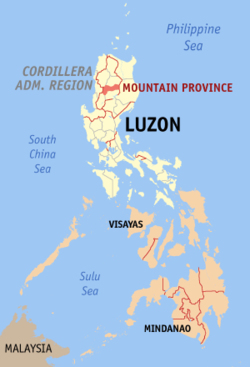Mountain Province
| Mountain Province | |||
|---|---|---|---|
| Province | |||
|
|||
 Location in the Philippines |
|||
| Coordinates: 17°05′N 121°10′E / 17.08°N 121.17°ECoordinates: 17°05′N 121°10′E / 17.08°N 121.17°E | |||
| Country | Philippines | ||
| Region | Cordillera Administrative Region (CAR) | ||
| Founded | 1908 | ||
| Capital | |||
| Government | |||
| • Type | Sangguniang Panlalawigan | ||
| • Governor | Boni Lacwasan (acting) (Independent) | ||
| • Vice Governor | Francis Tauli (acting) (Independent) | ||
| Area | |||
| • Total | 2,157.38 km2 (832.97 sq mi) | ||
| Area rank | 58th out of 81 | ||
| Population (2015 census) | |||
| • Total | 154,590 | ||
| • Rank | 76th out of 81 | ||
| • Density | 72/km2 (190/sq mi) | ||
| • Density rank | 75th out of 81 | ||
| Divisions | |||
| • Independent cities | 0 | ||
| • Component cities | 0 | ||
| • Municipalities |
10
|
||
| • Barangays | 144 | ||
| • Districts | Lone district of Mountain Province | ||
| Time zone | PHT (UTC+8) | ||
| ZIP code | 2616–2625 | ||
| IDD : area code | +63 (0)74 | ||
| ISO 3166 code | PH-MOU | ||
| Spoken languages | |||
| Website | mountainprovince |
||
Mountain Province (Filipino: Lalawigang Bulubundukin), is a landlocked province of the Philippines in the Cordillera Administrative Region in Luzon. Its capital is .
Mountain Province was formerly referred to as Mountain in some foreign references. The name is usually shortened by locals to Mt. Province. The province was named so for being in the Cordillera Central mountain range found in the upper realms of Luzon island.
Mountain Province was also the name of the historical province that included most of the current Cordillera provinces. This old province was established by the Philippine Commission in 1908, and was later split in 1966 into Mountain Province, Benguet, Kalinga-Apayao and Ifugao.
The province is also known for its mummy caves, which contain naturally mummified bodies, and for its hanging coffins.
The area of the Cordillera mountains proved difficult to control by the Spaniards. From 1566 to 1665, they sent expeditions to conquer the land but the rugged terrain and hostile indigenous population at the time were major obstacles to complete subjugation.
Formerly called La Montañosa by the Spanish colonizers due to its mountainous terrain, the area was subdivided into 6 comandancias politico-militar.
In August 19, 1908, during the American rule, the Philippine Commission enacted Act No. 1876, which organized the entire area of the Cordilleras into one large province, named Mountain Province.
The first governor was Samuel Cane, and the was made the capital. It was originally composed of the sub-provinces of Amburayan, Apayao, Benguet, Lepanto-Bontoc, Ifugao and Kalinga.
...
Wikipedia


